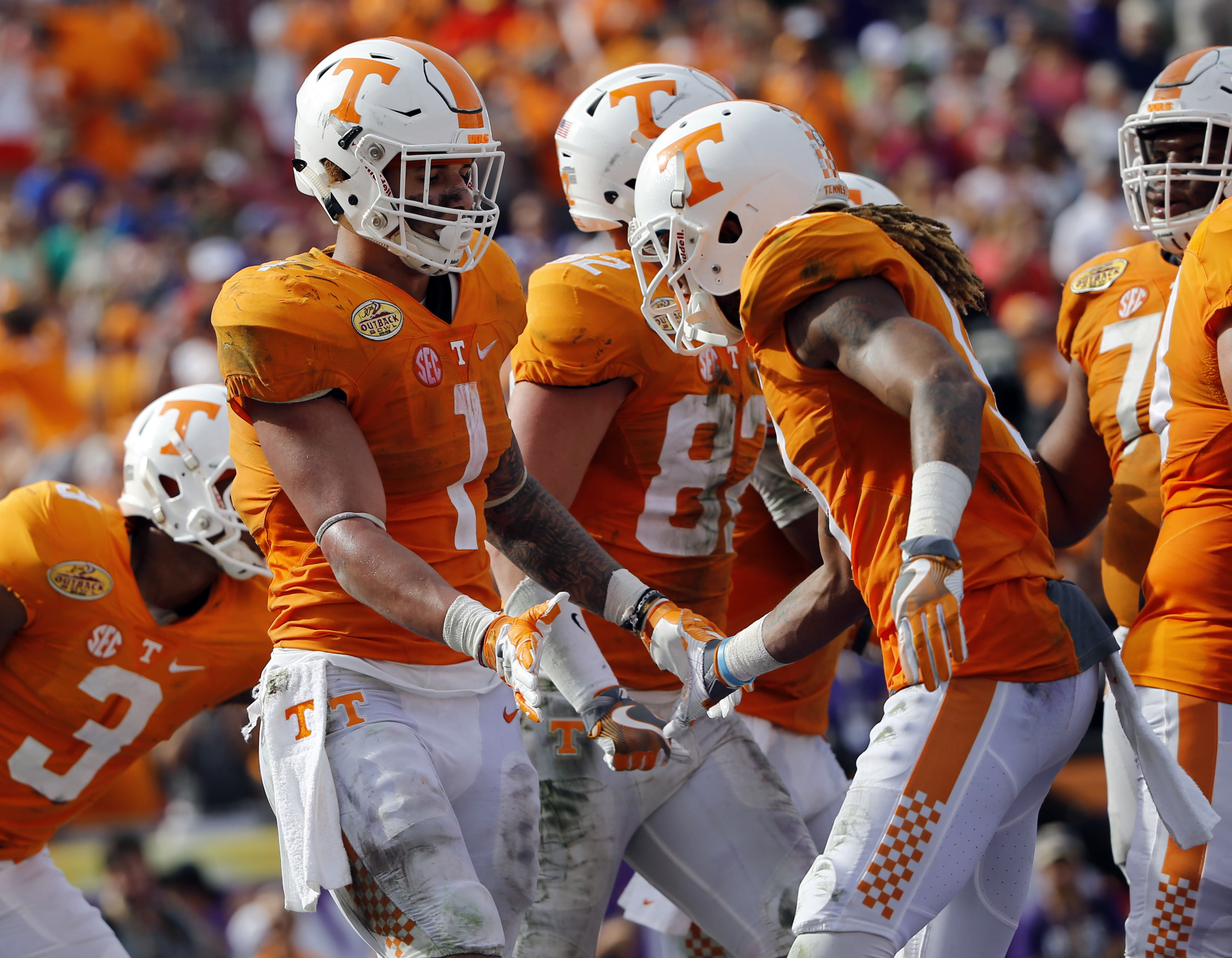
O? No.
That’s a succinct description of SEC East offenses in 2015, when the division produced the six lowest-scoring teams in the conference.
Will 2016 be any better?
Here’s what we can expect to see.
1. Tennessee
2015 points per game: 35.2, third in the SEC.
Better or worse in 2016? Better.
Why? The Volunteers have an answer for any situation, which is the hope and dream of every offensive coordinator. They run so many plays out of the same look that it’s difficult to predict where the ball is going.
Joshua Dobbs isn’t the fastest, most elusive dual-threat the SEC has seen, but he accounted for 26 touchdowns and nearly 3,000 total yards last season. He led SEC quarterbacks with 671 rushing yards.
Defenses have to focus on Jalen Hurd, who has Derrick Henry’s size and finished fourth with 1,288 rushing yards last season.
Northwestern coach Pat Fitzgerald said the Vols out-schemed his Wildcats in the Outback Bowl on two long passes to little-used tight end Alex Ellis because his defense was so preoccupied with stopping Dobbs and Hurd.
2. Florida
2015 points per game: 23.2, 11th in the SEC.
Better or worse in 2016? Better.
Why? Jim McElwain will have months to devise a game-plan around a quarterback he selects, rather than days to rebuild one for a quarterback he was forced to play.
That will be the biggest difference between 2016 and the second half of 2015.
The 2016 Gators also will have a better rotation at running back, led by JUCO transfer Mark Thompson. And McElwain added three of the top 32 receivers in the 2016 class to supplement 2015 breakout star Antonio Callaway, whose future is shrouded in secrecy.
If nothing else, the Gators can count on six or nine extra points per game from kicker Eddy Pineiro.
3. Georgia
2015 points per game: 26.3, ninth in the SEC.
Better or worse in 2016? Better.
Why? Like McElwain, Mark Richt was forced to rewrite the offensive script in mid-season after Nick Chubb’s injury, and that rarely works.
Richt obviously is gone, but Kirby Smart and his staff enter spring not necessarily counting on Chubb to be there opening day. So there won’t be any what-now moments in fall camp when he’s not ready.
Sony Michel proved he is a capable back in 2015; he just requires a different mode of attack from Chubb.
Greyson Lambert quickly became a scapegoat for Georgia’s offensive woes, but his 12-to-2 touchdown-to-interception ratio was the best in the SEC.
Georgia has an emerging star in Terry Godwin to offset the loss of Malcolm Mitchell.
Put it this way: Georgia is much better off on Jan. 10 than it was at any point after Chubb’s season-ending injury.
4. Kentucky
2015 points per game: 24.7, 10th in the SEC.
Better or worse in 2016? Better.
Why? New offensive minds Eddie Chan and Darin Hinshaw will simplify the formations and develop Drew Barker into the quarterback most think he can be.
The Wildcats return plenty of play-makers, too, including running back Stanley “Boom” Williams, who was on pace for a 1,000-yard season had he been healthy all season.
Playing Alabama will alter anybody’s scoring average, but the starting offense returns almost entirely intact, including the receivers.
Motivation is the strongest intangible in sports — and Kentucky has plenty of it after back-to-back disappointing finishes.
5. South Carolina
2015 points per game: 21.9, 12th in the SEC.
Better or worse in 2016? Worse.
Why? South Carolina lost its best offensive mind (Steve Spurrier), its best offensive player (Pharoh Cooper) and its best running back (Brandon Wilds).
Getting back to 21.9 points is a very modest goal, but that might be the Gamecocks’ ceiling.
Lorenzo Nunez is the X-factor. If he shows he can move the ball with his arm, South Carolina’s offense becomes much more dangerous because he already has proven he can make big plays with his feet.
Kurt Roper will design plays for Nunez regardless. He did the same thing at Duke with Brandon Connette, who essentially was a running specialist as the backup quarterback to pocket passer Anthony Boone.
6. Vanderbilt
2015 points per game: 15.2, 13th in the SEC.
Better or worse in 2016? Better.
Why? The only way it could get worse is if Ralph Webb is injured because Vanderbilt absolutely punted on the passing game in 2015.
The hope is Kyle Shurmur can erase the nightmare of last season and take a step toward reaching his four-star recruiting profile.
Webb is a solid place to start any offense, and Trent Sherfield caught 51 balls last season — 26.5 percent of Vandy’s 192 completions. That was a higher percentage than Ole Miss standout Laquon Treadwell (25.7).
7. Missouri
2015 points per game: 13.6, last in the SEC.
Better or worse in 2016? Worse.
Why? Even with a more proven Maty Mauk, the Tigers failed to throw for more than 230 yards in their four of their first five games in 2015.
Drew Lock was pressed into duty and played like a true freshman, throwing four touchdown passes against eight interceptions.
The offensive production was the worst in Gary Pinkel’s distinguished career.
Now Lock gets a new head coach, new offensive coordinator, rebuilt offensive line and (technically) a new starting running back in Ish Witter.
Yes, his top receivers return, but it’s an uphill battle to the end zone.
Managing Editor
A 30-time APSE award-winning editor with previous stints at the Miami Herald, The Indianapolis Star and News & Observer, Executive Editor Chris Wright oversees editorial operations for Saturday Down South.






